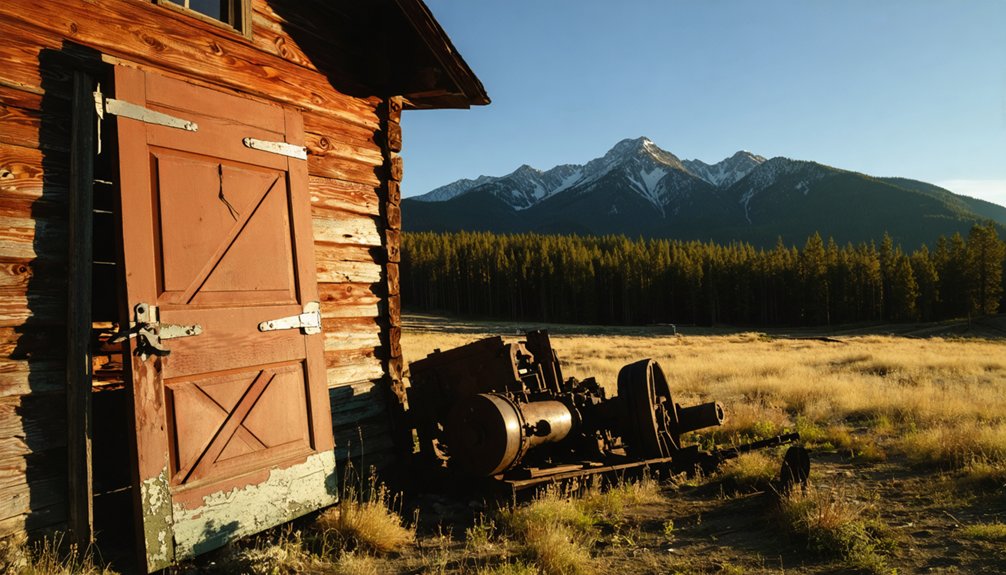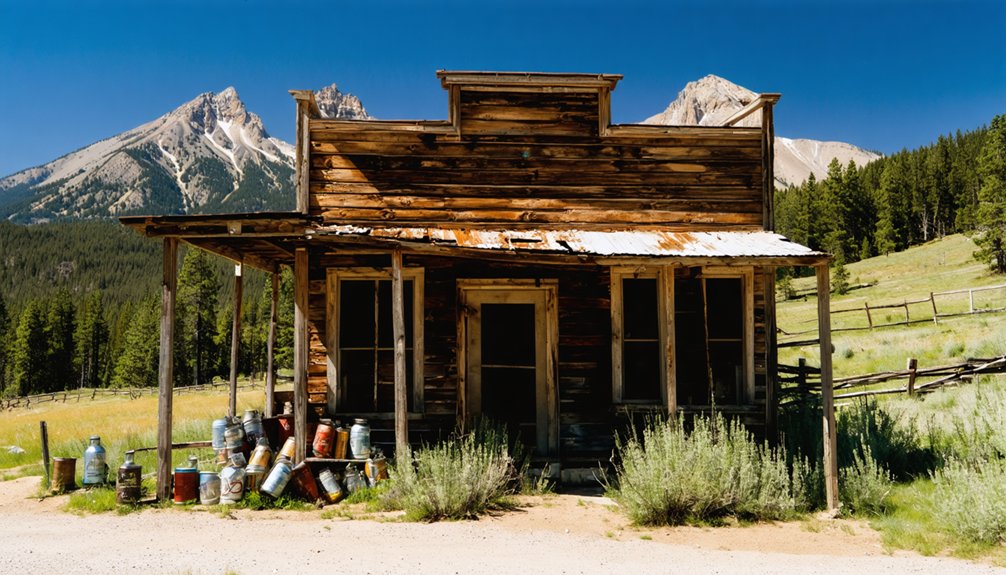You’ll find Mineral City, a mesmerizing silver mining ghost town from the 1880s, tucked away in Washington County, Idaho’s rugged terrain. The site produced over $12.5 million in precious metals before its decline, leaving behind brick-walled buildings, a weathered schoolhouse, and scattered miners’ cabins. You’ll need a high-clearance 4×4 vehicle to access this remote location via County Road 70 from Weiser. The town’s rich history and stunning canyon landscape hold countless stories waiting to be discovered.
Key Takeaways
- Mineral City was established in the 1880s as a silver mining boomtown, producing over $10 million in minerals by 1898.
- Visitors can find brick buildings, a weathered schoolhouse, and miners’ cabins among the remaining structures.
- Access requires four-wheel-drive vehicles via County Road 70 from Weiser, Idaho, with preparation for remote conditions.
- The site contains hazards including rattlesnakes, unstable structures, and contaminated streams near historic mining areas.
- Preservation guidelines prohibit artifact removal and encourage photography while respecting the site’s historical significance.
The Discovery of Silver and Town Origins
The discovery of silver in Idaho during the 1860s marked a pivotal shift from gold mining to silver extraction, ultimately leading to the establishment of Mineral City.
Silver’s discovery in 1860s Idaho revolutionized the region’s mining focus, paving the way for Mineral City’s founding.
Like the early Eagle City settlement, initial prospecting focused on gold before transitioning to more profitable silver operations.
As miners ventured deeper into Idaho’s rich mineral deposits, they utilized the revolutionary Washoe process, which transformed silver mining throughout the region.
You’ll find that Mineral City emerged as a quintessential boomtown during this era, experiencing the dramatic population swings typical of mining settlements.
The town quickly developed a vibrant community complete with homes, schools, and essential services.
The silver mining operations attracted waves of prospectors and entrepreneurs, all seeking their fortune in Idaho’s promising terrain.
While some mining towns flourished and others failed, Mineral City stood as a symbol of the bold spirit of western expansion, though it eventually succumbed to the familiar pattern of boom-and-bust that defined the era.
The region’s first major silver discovery in 1864 yielded remarkable assays worth $9,800 per ton in combined gold and silver.
Getting There: Routes and Road Access
Modern-day adventurers seeking to explore Mineral City’s historic remnants must commence on a journey from Weiser, Idaho, following a carefully planned route through remote terrain. Like many abandoned settlements, the site attracts history enthusiasts and adventurous travelers.
You’ll head west-northwest on County Road 70, turn right onto Jonathan Road, and drive 22.8 miles north until you reach the turnoff near Brownlee Reservoir.
Road conditions demand a high-clearance, four-wheel-drive vehicle as you navigate unpaved jeep trails ascending rugged ridges. Visitors should watch for Northern Pacific Rattlesnakes while exploring the area.
Keep these essentials in mind:
- Pack emergency supplies and extra fuel – you’re entering true wilderness
- Monitor weather forecasts closely – conditions can change rapidly in Hell’s Canyon
- Use GPS coordinates and backup navigation – cell service is unreliable, and signage is sparse
The final two miles before Brownlee Reservoir reveal the right-hand turnoff to Mineral City’s remains.
Natural Hazards and Wildlife Awareness
While exploring Mineral City’s historic remnants offers a fascinating glimpse into Idaho’s mining past, visitors must stay alert to numerous natural hazards that exist throughout Hell’s Canyon.
You’ll need to watch for Northern Pacific Rattlesnakes, which are abundant in the area. The terrain’s rugged nature and unpredictable weather demand proper hazard preparedness, including appropriate gear and navigation tools.
For wildlife safety, maintain distance from any animals you encounter and be especially cautious of red-orange vegetation that’s likely poison ivy. Any water in streams near the old 20 stamp dry crusher exhibits dangerous contamination levels.
The high desert climate brings extreme temperatures, and sudden storms can trigger flash floods. Don’t drink from natural water sources, as they may be contaminated from historic mining activities.
Watch for unstable structures and remember that cell service is often unreliable in this remote location. Idaho’s arid climate conditions have helped preserve many of the abandoned structures for exploration.
Ghost Town Structures and Remnants
Standing as silent witnesses to Idaho’s mining era, Mineral City’s remaining structures paint a compelling picture of frontier life in Hell’s Canyon.
You’ll find brick-walled buildings, including a weathered schoolhouse and miners’ cabins, constructed with railroad ties and giant nails. While fire has claimed some structures, leaving only smooth dirt floors and scattered artifacts, others still reveal glimpses of original wall decorations. The discovery of old stove pipes throughout the buildings provides evidence of different construction periods.
- The old schoolhouse stands defiant against time, its walls holding stories of frontier education.
- Miners’ cabins, built with resourceful combinations of brick and railroad ties, showcase the ingenuity of early settlers.
- Fire-damaged buildings contain poignant remnants – old bed frames and spoons that whisper tales of daily life.
Nature’s slow reclamation through tumbleweeds and vegetation adds an ethereal quality to these historic remnants. Much like Silver City’s last resident, the buildings stand as lonely sentinels of a bygone era.
Historical Mining Operations
Three pivotal decades defined Mineral City‘s rise as a silver mining powerhouse, beginning with its discovery in 1880 and formal organization in 1881.
You’ll find that early mining techniques included both underground and surface operations, supported by two local smelters installed by 1890 to process the valuable ore.
Similar to the flotation processes pioneered at Bradley Mining Company, the economic impact was substantial – by 1898, the district and its neighbors had produced an impressive $10 million in minerals, primarily silver.
The region’s mineral deposits formed during the Cretaceous period, with veins extending deep below the surface along faults and fractures.
Later revival efforts in the 1910s and 1920s added another $2.5 million to the total. The Clayton silver mine‘s steady operations after 1935 more than doubled previous production totals, exceeding $12.5 million.
Mining technology evolved continuously, with improved ore processing methods developed to handle the area’s rich polymetallic deposits of silver, zinc, and lead.
Exploring the Canyon Landscape
Deep volcanic canyons surround Mineral City, carved through ancient lava flows of basalt and rhyolite over millions of years.
Ancient volcanic forces shaped these dramatic canyons, where time and erosion reveal the story of molten rock turned to stone.
You’ll encounter dramatic cliffs shaped by the Snake River’s relentless erosion, where canyon geology reveals layers of volcanic history.
The rugged landscape showcases volcanic features like towering rhyolite walls and dark basalt columns that create an otherworldly atmosphere.
- Scale steep canyon rims for breathtaking views of the Bruneau Canyon’s 212-foot waterfall thundering over ancient lava beds
- Discover boulder fields formed by weathered volcanic rock, creating natural climbing features reminiscent of the City of Rocks
- Explore narrow gorges where millions of years of water flow have exposed stunning layers of volcanic rock
Preservation Tips for Visitors

When visiting Mineral City’s historic remains, you’ll need to follow essential preservation guidelines to protect this fragile ghost town for future generations.
Proper visitor etiquette starts before you arrive – research access routes, check weather conditions, and verify your vehicle can handle remote terrain. Pack safety essentials and navigation tools, as cell service is unreliable.
Once on-site, stick to established trails and watch for Northern Pacific rattlesnakes and poison ivy. Don’t touch unstable structures or remove artifacts – take photos instead.
Key preservation techniques include packing out all trash, avoiding off-road driving, and respecting private property boundaries. You’ll also want to steer clear of graffiti or vandalism.
Consider supporting local historical societies and sharing your experiences responsibly to encourage sustainable tourism.
Legacy of Idaho’s Mining Era
Idaho’s mining legacy stretches far beyond the scattered ruins of ghost towns like Mineral City, having generated over $3.42 billion in mineral production between 1860 and 1969.
This industrial heritage shaped not only the state’s economy but also its cultural identity, with mining towns demonstrating remarkable community resilience through boom-and-bust cycles.
- You’ll find evidence of technological innovation in places like the Morning and Star mines, where complex ore processing methods revolutionized mineral extraction.
- You can trace the evolution of Idaho’s environmental consciousness through the shift from unrestricted mining to today’s balanced approach of conservation and remediation.
- You’re witnessing living history in Shoshone County’s dominant role in silver, copper, lead, and zinc production, which transformed Idaho from frontier territory to economic powerhouse.
Frequently Asked Questions
Can You Camp Overnight Near the Ghost Town Site?
Where there’s a will, there’s a way – you’ll find plenty of camping spots near the ghost town, following standard camping regulations. You’re allowed up to 14 days, but don’t expect ghost town amenities.
Are There Any Guided Tours Available to Mineral City?
You won’t find guided tour options or local tour operators at this site. You’ll need to explore independently, as it’s a remote location accessed via rugged roads requiring your own transportation.
What Is the Best Season to Visit Mineral City?
Spring (April-May) offers you the best weather and ideal exploration conditions. You’ll enjoy comfortable temperatures, accessible roads, and seasonal activities while avoiding peak rattlesnake season and summer crowds.
Are Metal Detectors Allowed at the Ghost Town Site?
Like many treasures buried in time, metal detecting regulations here aren’t crystal clear. You’ll need to contact local authorities about historical preservation policies before using your detector at this protected site.
Is Photography Permitted Inside the Remaining Structures?
You’ll need to verify photography rules with local authorities, as access to structures isn’t clearly documented. Due to safety concerns about structural integrity, entering buildings isn’t recommended without proper permission.
References
- https://www.owyheejack.com/owyhee-jacks-meanderings/central-idaho/mineral-city-ghost-town
- https://history.idaho.gov/wp-content/uploads/2018/08/0064.pdf
- https://www.ghosttowns.com/states/id/mineralcity.html
- https://www.idahogeology.org/pub/Bulletins/B-22.pdf
- https://www.youtube.com/watch?v=rTSZSlxTmbs
- https://visitidaho.org/things-to-do/ghost-towns-mining-history/
- https://www.youtube.com/watch?v=Au2IYj9jA00
- https://westernmininghistory.com/towns/idaho/silver-city/
- https://history.idaho.gov/wp-content/uploads/2018/12/0160.pdf
- http://modeshift.org/419/idahos-silver-valley-a-story-of-wealth-tragedy-and-transformation/



